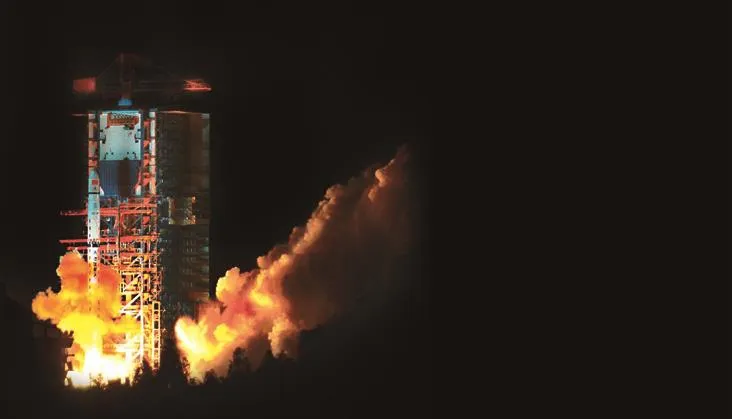Chang’e 4 Relay Satellite Queqiao Launched Atop A LM-4C
2018-02-20PhotoLIMing
Photo: LI Ming

China launched a relay satellite named Queqiao on a LM-4C launch vehicle from the Xichang Satellite Launch Center at 05:28 Beijing time on May 21, 2018. It is the world’s first communications satellite that operates in the orbit around the second Lagrangian (L2) point of the Earth-moon system,and will provide Earth-moon relay communications for the Chang’e 4 lunar probe to soft-land on and rove the far side of the moon which is planned to be launched in late 2018.
The satellite separated from the rocket and entered an Earth-moon transfer orbit with the perigee at 200 km and the apogee at about 400,000 km. Queqiao braked 100 km above the surface of the moon in line with instructions from the ground control center in Beijing, and then entered a transfer orbit from the moon to the L2 point of the Earth-moon system at 21:46 Beijing time on May 25. The satellite orbited precisely and conducted only 1, instead of 3, mid-course corrections as planned due to the high launching precision of the LM-4C launch vehicle. At 11:06 Beijing time on June 14, the satellite conducted its orbital acquisition control successfully and then entered a halo orbit around the L2 point about 65,000 km from the moon.
Queqiao will be tested in the halo orbit and operations verified. The satellite will provide relay communication to build a communications bridge between the Earth and the moon with a distance of more than 400, 000 km where the Chang’e 4 lunar probe is expected to touch down in late 2018.
Queqiao is the world’s first relay communications satellite that will operate beyond the Earth orbit, linking the Earth and the Moon, and entered a halo orbit around the L2 point, demonstrating China has mastered Earth-moon relay communications technology which is a new breakthrough for China in the lunar exploration field.
Chang’e 4 will be the world’s first to carry out a landing and probe mission to the far side of the moon, applying the technical solution of “soft-landing on and rovering the far side of the Moon + relay communications via the Earth-moon L2 point”.
Chang’e 4 mission will be completed in two launches. The first is to launch the Chang’e 4 relay satellite. The second is to launch Chang’e 4 probe and rover after the relay satellite is confirmed to be operating stably at the Earth-moon L2 point.This will then enable a soft-landing on the far side of the moon in the Antarctic Aitken Basin and carrying out relay communications with the Earth through the relay satellite.
The satellite was developed by China Spacesat Co, Ltd.,under the China Academy of Space Technology (CAST) and named as Queqiao on the 3rd National Space Day in 2018.The satellite weighs about 448 kg, and is based on a CAST100 satellite bus with a lifetime of 3 years.
The relay satellite carries a 4.2 m high gain parabolic antenna which is a communications antenna with the highest caliber in the history of human deep space exploration. It can realize three-axis stable control of pointing and tracking of arbitrary targets on the Earth, the moon, the sun and inertial space, plus realize the TT&C and data transmission between the lander,rover and ground station.
The LM-4C launch vehicle was developed by SAST. It is a three-stage liquid propellant rocket, with a three-stage engine in a second start-up condition. The launch vehicle is used to launch the SSO satellite, and also can launch other orbit satellites into Earth-moon transfer orbits. This was LM-4C’s first launch mission from the Xichang Satellite Launch Center.
This was the 275th flight of the LM series launch vehicle.This launch also carried two ultra-long wave microsatellites for astronomical observation which were developed by the Harbin Institute of Technology (HIT).
杂志排行
Aerospace China的其它文章
- Intelligent and Autonomous Flight Technology for Launch Vehicles
- LM-11— The Main Force in China’s Small Launch Vehicles for Commercial Launch
- LM-11SL: A Sea-Launched Carrier Rocket for Small Satellites and Its Launch Service
- QB50 Project and the Development of CubeSat Technology in China
- CAASSE Signed a MOU with HASSE
- Welcome to the First China International Symposium on Microsatellite
